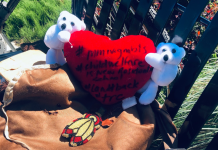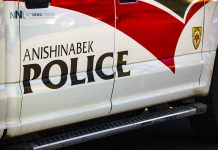Fort William First Nation, Anemki Wadjiw – I remember the first time I met Georjann Morriseau. She had responded to a call for help. In May 2008, more than 20 people from Grassy Narrows First Nation were walking from their reserve (near Kenora, Ontario), to Ottawa to protest logging in their territory. I invited the walkers to stay at my apartment in Thunder Bay to rest and prepare for the next part of their journey. I sent out a request for food and bedding to help me accommodate the walkers. Georjann was one of the first people to respond; she brought over enough food to feed every one of us that night. She didn’t ask for anything in return.
Thunderbeings in her heart
Today, Georjann is a candidate in the 2013 Fort William First Nation Chief and Council election. She has been nominated for the position of chief, as well as councillor. Georjann was first elected to the Chief and Council as a councillor in 2011. She has a solid grasp on how Anishinaabeg governance traditions can inform Band Office governance. She is an active member of several committees, has produced numerous governance materials and has been active in protests and other gatherings that focused on making Fort William First Nation the best community it can be. She has sacrificed her family time and her own interests for the people of my community.
But in the past several weeks, Georjann has come under attack. In running for chief, there have been people in our community who have taken it upon themselves to attack Georjann’s character through unfounded speculative claims. The attacks have taken place largely on Facebook; but, as of yesterday, the attacks have moved to the distribution of hard-copy materials, purportedly stolen from our Band Office, and purportedly demonstrating Georjann’s shady character.
Some have attempted to dismiss such attacks by saying that running for chief is dangerous business, and that turbulence is just part of the ride. Such a dismissal is a form of violence in and of itself, for it invisibilizes the actions of the attacker(s) while not recognizing that a young woman from our community is being hurt simply because she is active and committed. Attacking each other in the way demonstrated in Fort William First Nation during the past weeks is a form of cannibalism – we are eating each other alive from the inside out.
There are many stories about the dangers of cannibalism within Anishinaabeg intellectual and political traditions. The cannibal eats other humans. The more it eats, the more hungry it gets. Some have likened greed to cannibalism because the more someone feeds their greed, the more greedy they become – unable to fill the hole they’ve created within themselves. The result is that the hunger gets so great that eventually all that is good in the world is gone. Humans are inherently good, but the cannibal spirit has the ability to eat the best of us.
Anishinaabek have named this spirit “Wiindigo.” Wiindigos are found in our aadizookaanan (sacred stories) and dibaajimowinan (personal experiences). They live within us and within our communities. Sometimes the Wiindigo spirit is strong enough to take over our thoughts, actions and bodies. It is said that a person who has been taken over by Wiindigo spirit will eat other people, and that their chest is full of ice.
John Borrows shared a story about a person who was taken over with Wiindigo spirit in the 1830s. The story is about a man who came back to his community in the winter after walking days without food or fire. The man would do strange things, like eat an entire deer in two sittings, or walk on top of soft snow without sinking. Soon after his return, the man’s face turned the colour of death. He drank his own blood and was saying threatening things, to the point that others in the group became scared for their safety. The community came together and decided the man must have become a Wiindigo. Finally, after discussing what to do amongst themselves, it was decided the man must die so that he would not eat their children. The man’s best friend was chosen to kill him, which he did so that it would be carried out with the utmost of kindness and love.
There is also a story about how a woman killed Wiindgos to save her community. Its a story told by Caroline Anderson and Roger Roulette from northern Manitoba. The woman’s name was Gezhizhwazh. The name was translated by Caroline as “…’to try to cut,’ and refers to her willingness to be snacked upon by cannibals while she is waiting to murder them.” Roger translates the story into English as follows:
The story goes … she sacrificed herself to be taken by the Wiindigo because they were going toward where the Ojibwe people were living. And there was a band of them. So she thought, if she sacrificed herself to be taken by the Wiindigo, in that way, she’d have an eye on them, of what they were going to do, what their plans were, even though during the time she was with them, they would cut pieces of her and eat parts of her. But in order to save her own people, the Anishinaabe, she would be taken as lunch. And then she knew their plan. So, when she had the chance to go to the Anishinaabe village, she told them what the Wiindigo’s plans were. She wanted to be the first one to strike, and she also showed the Anishinaabe how to kill the Wiindigo. And she’s seen as a hero because she was the main killer of Wiindigo. And that’s the story.[1]
What is clear in both of these stories is that while Wiindigo can threaten the survial of Anishinaabeg communities, the way they are fought is through love of one’s community and self sacrifice. In the story told by John, the Wiindigo man was killed by his best friend; and the best friend then offered himself as a new son to the father of his friend now killed. This demonstrates kindness and empathy towards his friend, but also shows that balance must be maintained in the community: the man took the place of his friend, so that the friend’s family would not have to lose a son (in effect, he took on double the responsibility). In the story told by Caroline and Roger, Gezhizhwazh sacrificed herself so that her community could live; and through her sacrifice she brought new knowledge to her community so that it could survive.
Georjann’s work in our community in the past years reminds me of such sacrifice. She has gone above and beyond the call of duty to give back to our community. She has done so in the face of the cannibalizing spirit thats reared its head this week. In no way should anyone be made to endure such cannibalism just to give their gifts to us. But things are changing. The winter of 2013 has seen unprecedented change for Anishinaabeg everywhere. We are witnesses a collective political and intellectual awakening being led by the next generation of leaders. Idle No More is an example of this. And we have a sacred story about this time of change, known as the Seven Fires; it states that a New People will emerge after generations of our peoples being asleep. It is the job of the New People to bring about the changes that are needed in Fort William First Nation, and these changes can only come with the new thinking.
We have many stories about transformation in Fort William First Nation. One of our story tellers is Christian “Mick” Chapman, a visual artist. Mick tells stories through painting and imagery. His stories are about us, as a community. Given that some people in our community are cannibalizing Georjann simply because she has vision and is self-sacrificing, it makes sense to share a home-grown story about how change might come about within our community, and I look to Mick’s work to show us the way.
One of my favourite stories about transformation in Fort William First Nation is the story about the returning of the thunderbeings. Often, I forget that change comes only through the collective action of a community. While each of us might have a good idea that we think will “solve” our community’s problems, its important to remember that acting alone, while demonstrating leadership, might not lead to widespread transformation. The story of the return of the thunderbeings reminds us that for transformation to occur, it has to be in the hearts of the people.
Mick’s 2010 piece entitled “Anemki” embodies the story about the return of the thunderbeings. It is said that someday the thunderbeings will return to nest on our mountain, anemki wadjiw. Our mountain is a sacred place. But it has been impacted by more than a century of colonialism; for example, though it is sacred for many Anishinaabeg, it has a cross on it symbolizing christian domination of our people and our land. While it would be easy for a person acting alone to knock the cross off our mountain, this would not work because our community would only replace the cross, only in a more entrenched form and with more protection. When that cross comes down, it will be the result of many people coming together to remove it as a collective, as a means to reclaim our sacred site from the colonizing religion. The return of the thunderbeings is thus a story about our collective transformation: it is only through the return of the thunderbeings into our hearts that real change will occur.
To me, all of this speaks what is happening to Georjann today. Our election is two days away, and those people who have been attacking her are doing so from a place of mis-guided anger and a greed for power. Ice has filled their chests. Ironically, such attacks tacitly demonstrate that they see Georjann as a true, legitimate leader in our community. Otherwise, why would they be attacking her so vehemently?
To me, Georjann represents the emergence of the New People in our community who are going to bring about the transformation that we’ve been seeking for generations. Now is the time of the Seventh Fire – the New People are here and their spirit is embodied in Georjann’s tireless efforts to love our community. The thunderbings are in her heart.
Damien Lee
Read more of Damien’s thoughts at www.zoongde.wordpress.com
[1] Anderson, Carloine and Roger Roulette qtd. in Margaret Noori, “Beshaabiiag G’gikenmaaigowag: Comets of Knowledge. In Centering Anishinaabeg Studies: Understanding the World through Stories, eds. Jill Doefler, Niigaanwewidam James Sinclair and Heidi Keewetinepinesiik Stark (East Lansing: Michigan State University, 2013), 45.








